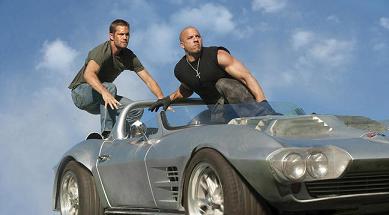Physics: Does It Really Matter In Movies?
 It’s clear after watching Fast Five that director Justin Lin flunked physics in
It’s clear after watching Fast Five that director Justin Lin flunked physics in
high school. How else can you explain the film’s delirious action sequences, moments where both actors and cars zoom across the screen as if untethered by gravity?
The film’s signature chase (mild spoiler alert!) involves two cars dragging a massive safe across the highway. You don’t need an abacus to realize they probably wouldn’t get very far doing that in real life, let alone out-race a squadron of cop cars in hot pursuit.
Audiences clearly don’t seem to mind the liberties taken by Vin Diesel and co. The film hauled in $85 million in its first weekend and continues to rake in the cash.
But Fast Five isn’t alone in tweaking the natural laws to goose our adrenal glands. Movies have done just that for decades. Did you really think James Bond could do all the things he does and not have a little help in the physics department?
Lately, filmmakers are getting better at shoving science aside. It’s all about more, more more, and the only way to up the ante on, say, four previous Furious installments is to trot out even hairier stunts.
The same holds true for recent movies like Knight and Day, Salt and The A-Team.
It’s part of the aesthetic landscape, and the better directors know how to use it their advantage. Count Lin in that category, although it’s a safe bet he giggled up his sleeve watching the film’s dailies.
So why don’t audiences mind when the on-screen action takes a turn for the absurd?
It’s all about consistency of presentation. There’s barely a moment in the Furious films that feels stripped from real life. Surely no one boasts biceps as big as Diesel’s or, in the latest film in the franchise, those belonging to Dwayne Johnson. And every scene pushes the proverbial envelope, so that by the time we watch those cars pulling a safe we’re almost numb to how surreal it really is.
A few films tweak this trend with giddy results, like the underrated Clive Owen film Shoot ‘em Up.
But modern filmmakers understand audiences are a forgiving lot. Throw a few engaging characters our way and stunt personnel who make the impossible a reality and we’ll tag along for the ride.
Even if it means swallowing hard as all those high school lessons flash before our eyes.


You’re right about how we come to accept the violations of physics and the laws of nature in the movies. It’s fine, I guess, for movies to make these exaggerations for our entertainment. But it would be interesting to see more action movies try to convey more of the reality of the difficulties of the stunts and the pain of the injuries, etc.
Good point — and, frankly, it might be a smart way for a future action movie to differentiate itself from the pack. Go for reality. It’s a gimmick that just might work.
Physics is important in some movies that needs to be realistic enough to be entertaining or it serves a purpose on the story but if it’s action packed films, sometimes its necessary to exaggerate some stunts to have a WOW effect to the film. I understand why some directors or producers allow this “glitch” or stunts if we call it that way, cause it gives intensity to the scene, so for me strict physics execution is really depending on what the scene is asking.